Discover the Benefits of Curved Computer Monitors
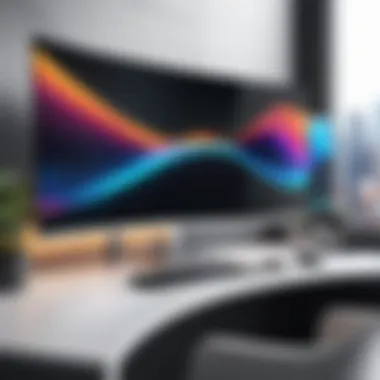
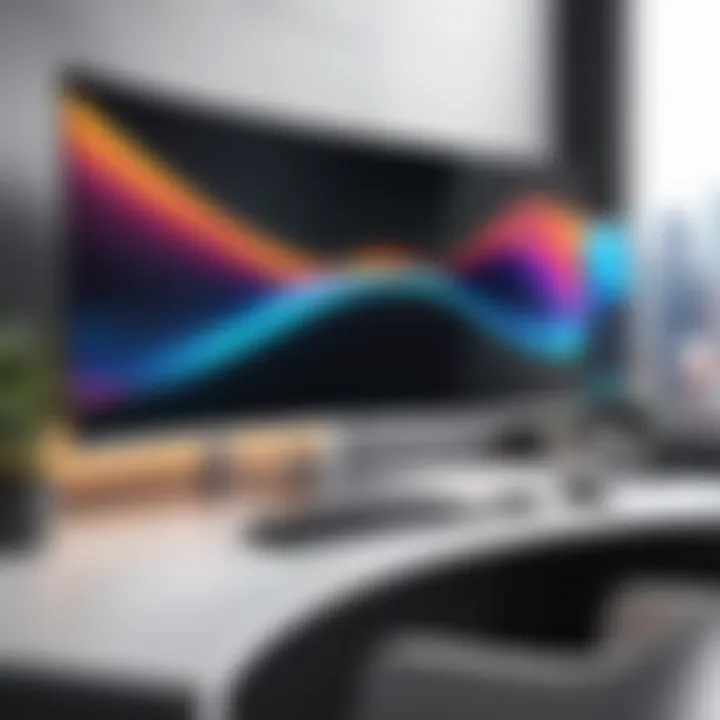
Intro
Curved computer monitors represent a significant evolution in display technology. Their appearance is not only visually appealing, but they also promise a variety of benefits that aim to improve overall user experience. Understanding these advantages is essential for individuals looking to upgrade their workspace. From gamers seeking immersive environments to professionals needing comfortable viewing angles, the appeal of curved monitors is growing steadily.
Overview of the Technology
Curved displays are designed to enhance the viewing experience through their unique shape. Unlike traditional flat monitors, curved monitors are constructed to wrap around the user’s field of vision. This subtle curvature can help to create a more immersive viewing experience.
Key specifications
A typical curved monitor features a specific radius of curvature. This measurement is often expressed in millimeters, such as 1800R or 1500R. Here, the 'R' refers to the radius, which indicates how tight the curve is. A smaller number denotes a more pronounced curve. Many curved monitors also support high refresh rates, ranging from 60Hz to over 144Hz, along with quick response times.
Unique selling points
One of the defining features of curved monitors is their ability to minimize distortion and glare. The curvature fosters better light distribution and can significantly reduce reflections from ambient lighting. Additionally, these monitors often include enhanced color accuracy and wider viewing angles when compared with flat displays. This makes them particularly appealing for designers and video editors.
Design and Build Quality
A well-designed curved monitor does not only focus on aesthetics but also includes robust construction and ergonomic design.
Material used
Most curved monitors utilize high-quality plastic for their bezels and back covers, while the screens themselves may be constructed with glass or advanced LCD technologies. This combination not only contributes to durability but also to a sleek, modern appearance that can complement various workspaces.
Ergonomics and usability
Ergonomics plays a vital role in the usability of curved monitors. The design aims to reduce eye strain by naturally matching the curvature of the human eye. The typical viewing distance can also be shorter without compromising image quality. Many models offer adjustable stands that allow users to customize height and tilt, further enhancing comfort.
"Curved monitors are not just a trend; they're a functional improvement that can redefine how we interact with digital content."
With increasing focus on comfort and engagement, notably in professional settings, curved monitors emerge as an effective tool to enhance productivity. Understanding these features and benefits will empower consumers to make an informed decision when considering an upgrade.
Foreword to Curved Monitors
Curved monitors have gained attention for their distinctive shape and promise of an enhanced viewing experience. They stand in contrast to traditional flat screens, which are often perceived as limiting in context to immersion and ergonomics. Understanding the role these monitors play in a contemporary workspace is vital. Their architecture may hold the key to both productivity and comfort, especially as more people transition to home and hybrid work environments.
Definition and Overview
Curved monitors are displays that adopt a gentle arc, allowing them to wrap around the viewer’s field of vision. This design can reduce the strain on the eyes by minimizing the need for constant adjustment between near and far areas of the screen. The curvature is typically described by the radius of the screen's bend, with common radii being 1800R or 1500R, where a smaller number means a more pronounced curve.
The vast majority of curved monitors utilize LCD technology, with some even featuring OLED capabilities. This has made them popular not just among gamers, but also among professionals seeking to optimize their setup. Features such as high resolutions and refresh rates can elevate both gaming and productivity tasks. Furthermore, the curvature can enhance peripheral vision, allowing users to see more of their workspace at once without turning their heads excessively.
History and Evolution
The concept of the curved monitor is not new. Early iterations included CRT monitors that were naturally curved due to the technology of cathode ray tubes. As flat panel displays became prevalent, the focus shifted away from curves until recent advancements revived interest. The introduction of LCD technology in the 21st century offered opportunities for reshaping monitor designs.
In 2013, Samsung launched the first commercially viable curved display, the Samsung SE790C. This product aimed to create a more immersive viewing experience using the existing display technology. Since then, multiple competitors have entered the market and improved the technology significantly. This has resulted in a range of options for consumers, enhancing the standard of visual quality and ergonomic design.
As technology progresses, curved monitors have evolved to incorporate higher refresh rates, faster response times, and better color accuracy. The push toward ultra-wide formats has further reinforced the technology’s relevance, offering expansiveness that caters to multitasking—an essential requirement for today’s digital workspace.
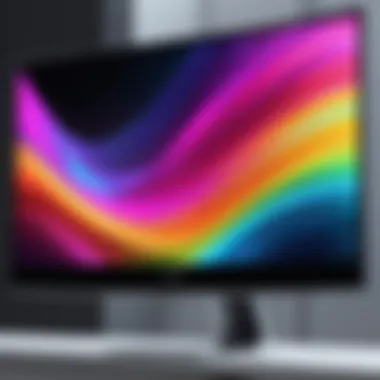
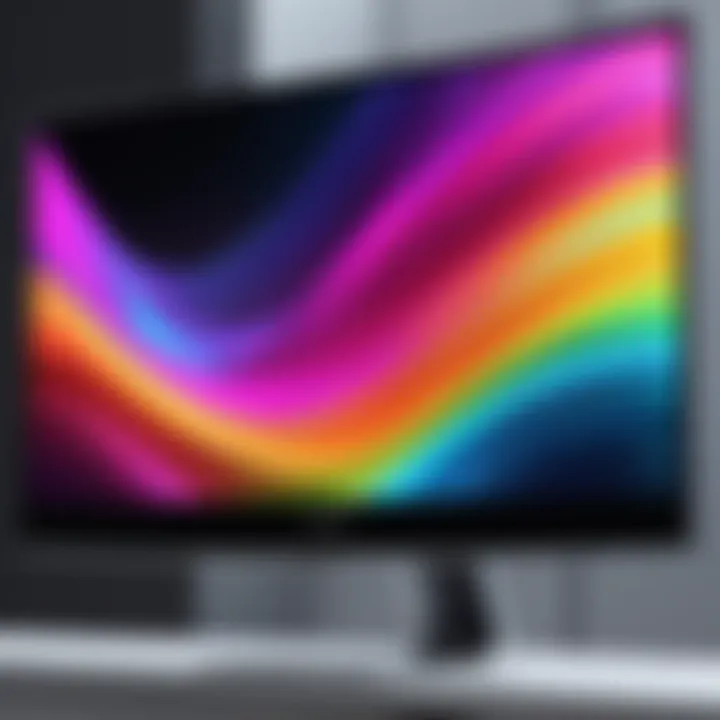
Visual Comfort and Ergonomics
The significance of visual comfort and ergonomics in the context of curved computer monitors cannot be overstated. These factors contribute greatly to the overall user experience, impacting everything from productivity to health and well-being. When a monitor is designed with the viewer’s comfort in mind, it helps create a workspace that is not just efficient but also pleasant to use for extended periods. Curved monitors offer features that address various discomforts often associated with long hours in front of a screen.
Reduced Eye Strain
Eye strain can lead to various issues, including headaches and fatigue. Curved monitors help alleviate this by providing a more natural viewing angle. The design of a curved screen means that the entire display surface is at a uniform distance from the eyes, which can reduce the amount of strain placed on the eye muscles. Users often find that they can spend longer amounts of time in front of these screens without experiencing discomfort.
Additionally, the curvature aids in minimizing reflections from nearby light sources. This reduction in glare contributes significantly to a better viewing experience. According to studies, less glare means lower chances of eye fatigue. Curved displays have been found to enhance visual comfort considerably compared to their flat counterparts.
Natural Field of View
Curved monitors are tailor-made to follow the natural curvature of the human eye. This design principle allows for a panoramic view that feels more organic and less distorted. Unlike flat screens, which can cause the viewer to turn their neck or shift their position to see different parts of the display, a curved monitor allows for a more comfortable positioning.
This can be especially beneficial in professional settings, where users often split their focus between multiple open applications. The natural field of view provided by the curved screen makes the content appear more immersive and less demanding on the viewer’s eyes. By allowing users to see the entire display without moving their head or body excessively, productivity can be enhanced.
Enhanced Immersion
One of the most attractive aspects of a curved screen is the immersive experience it creates. The design wraps the image around the viewer, creating a sense of depth and dimensionality. This is particularly beneficial for gaming and graphic design. When using curved monitors, users often find that they can engage more deeply with content, whether it’s a game or a design project. This enhanced immersion leads to greater focus and a more enjoyable experience overall.
Moreover, the immersive nature of curved monitors can make them ideal for collaborative workspaces. When multiple viewers are involved, the curvature allows several people to experience the same display effectively. This feature makes curved monitors not just a solitary tool, but a resource that enhances group discussions and teamwork.
"Curved monitors offer a blend of comfort and immersion that traditional flat screens often struggle to provide. The user-centric design can profoundly enhance one's working and viewing experiences."
In summary, the aspect of visual comfort and ergonomics in curved computer monitors represents an innovative approach to display technology. It addresses common concerns such as eye strain and discomfort while also promoting an engaging and immersive viewing experience. Understanding these benefits can guide users in making informed decisions toward improving their workspace.
Visual Performance and Quality
Visual performance plays a crucial role in how users interact with their monitors. Curved computer displays are designed to enhance this performance by addressing some common visual issues faced with traditional flat screens. High-quality visual experiences contribute to overall user satisfaction, be it for work or leisure. In this section, we will explore specific elements that showcase the advantages of curved monitors regarding visual performance and quality. These benefits are particularly relevant for tech-savvy users who value superior display features.
Wider Viewing Angles
One of the significant benefits of curved monitors is their wider viewing angles. With traditional flat monitors, viewers often encounter color shift or image distortion when viewing from an angle. Curved screens, however, present a more uniform image that minimizes these issues.
The curvature of the screen ensures that the light coming from the display reaches the viewer’s eyes more directly. This can be especially beneficial for collaborative environments where multiple users might be looking at the screen simultaneously. Instead of having to adjust the monitor position, users can gather around a curved display and still enjoy clear visuals. This feature is particularly appealing in workplaces or gaming setups where screen sharing may be necessary. Curved monitors thus allow for a more inclusive viewing experience.
Better Contrast and Color Accuracy
In discussions about visual performance, color accuracy and contrast are essential factors. Curved monitors tend to provide better contrast and color reproduction than their flat counterparts. The way light is dispersed on a curved screen reduces reflections and glare.
Such advancements in display technology enhance the vibrancy of colors, allowing users to enjoy a richer visual experience. This is particularly beneficial for tasks involving graphic design, video editing, or any creative work where accurate color representation is critical. Having a monitor that showcases more accurate colors can make a substantial difference in the quality of output.
Minimized Distortion
When it comes to distortion, curved monitors excel in providing users with a more immersive experience. Many flat monitors struggle with image distortion at the edges, impacting the overall clarity of the display.
Curved screens, however, minimize these problems. The design naturally draws the viewer's eyes toward the center of the screen, ensuring a consistent image across the entire display. This gives users a sense of presence, especially in gaming or video playback.
Moreover, the reduced distortion is useful in professional settings, as it leads to more accurate benchmarks for productivity and analysis. Users can confidently work on tasks without being distracted by visual artifacts that detract from their focus.
"Curved monitors are not just about aesthetics; they are designed to improve how we interact with visual content, enhancing both function and experience."
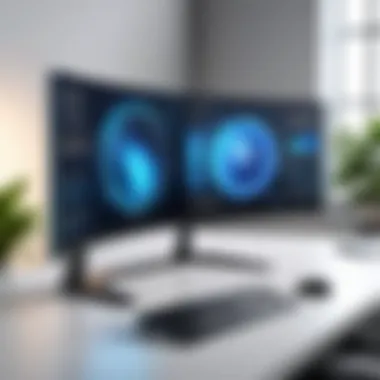
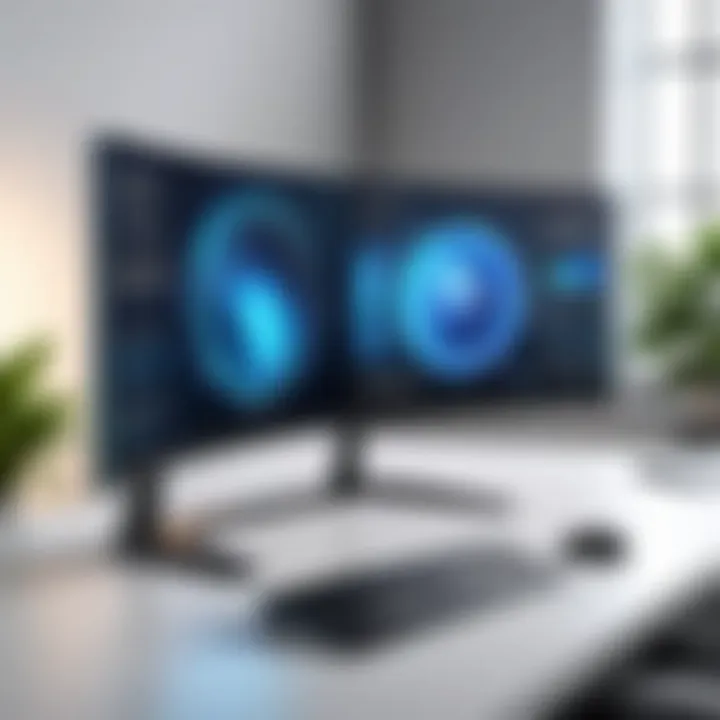
In summary, the aspects of visual performance and quality regarding curved monitors are vital. They address common issues found in traditional displays while providing opportunities for improved experiences in various applications. For anybody considering an upgrade, these advantages offer strong reasons to explore curved options further.
Productivity Enhancements
The emergence of curved computer monitors has significantly influenced productivity in both professional and personal environments. Their design offers unique benefits that contribute to a more efficient workflow. It is vital to understand how these monitors can enhance focus, facilitate multitasking, and ultimately improve overall productivity. The next sections will delve into two specific aspects of productivity enhancements: improved focus and concentration, and multitasking capabilities.
Improved Focus and Concentration
Curved monitors can play a pivotal role in enhancing focus and concentration during tasks. The natural curvature of the screen helps the viewer maintain eye alignment, reducing the need for repetitive adjustments to one's gaze. This factor can diminish fatigue during long sessions of work or gaming.
Further, a curved monitor envelops the viewer's peripheral vision. This immersive effect reduces the potential for distractions that might arise when using flat screens where elements can easily slip out of sight. The ongoing integration of a focused field of view helps the user remain centered on the tasks at hand.
In studies, users have reported that they felt less distracted and more engaged when using curved monitors compared to traditional displays. Creating a dedicated workspace that includes a curved monitor has been noted to foster an environment where deep concentration can thrive. The ergonomic design aligns with the natural position of the human eye, naturally supporting sustained focus in complex tasks.
Multitasking Capabilities
Curved computer monitors excel in supporting multitasking, a vital skill in many modern workplaces. The increased field of vision allows users to arrange multiple open applications side by side without compromising clarity. With a broader workspace, individuals can easily switch between documents, spreadsheets, and communication tools. This efficiency is ideal for professionals who often juggle various projects simultaneously.
Moreover, the ability to use split-screen functionality on larger curved displays enhances productivity. Users can run two or more applications in view, making it convenient to compare documents, conduct data analysis, or manage emails while working on reports.
Besides, many curved monitors support advanced features like Picture-by-Picture, enabling seamless viewing without unnecessary disruptions. This type of functionality allows individuals to remain organized and efficient without the hassle of constantly opening and closing tabs across multiple screens.
Overall, the productivity enhancements offered by curved monitors underscore their value in today's fast-paced, multitasking-heavy environments. With improved focus and expanded multitasking capabilities, these monitors not only create a more visually appealing workspace but can also lead to better work efficiency and satisfaction.
Gaming Experience
The gaming experience is significantly enhanced with the use of curved computer monitors. Gamers seek to immerse themselves in their virtual environments. Curved displays align more closely with the natural shape of the human eye, allowing for a more engaging experience. This section addresses two key aspects of the gaming experience with curved monitors: increased immersion in gameplay and enhanced graphics performance.
Increased Immersion in Gameplay
Curved monitors create a more enveloping effect compared to flat screens. This is due to their design which draws the viewer into the content on-screen. The curved shape helps to fill the peripheral vision, which can lead to a more captivating experience. Gamers often find themselves more emotionally invested in games when they feel the action surrounds them.
Additionally, the slight curvature often creates a sense of depth. This is particularly beneficial in first-person and third-person gaming environments, where players need to perceive distances and spaces accurately. The sense of scale becomes more pronounced, which can influence gameplay strategies.
"The curvature of the monitor not only enhances immersion but also aids in attention span, allowing players to concentrate for longer periods."
Enhanced Graphics Performance
Another important aspect of curved monitors is their impact on graphics performance. Many curved models come with advanced technologies such as high refresh rates and adaptive sync. These features ensure smoother visuals during fast-moving scenes. Gamers will appreciate reduced motion blur and screen tearing, which can often detract from the experience.
Moreover, curved monitors can display colors and contrasts more accurately. The design reduces light reflections from the edges, enhancing the overall color performance. This can result in more vibrant visuals and deeper blacks. In competitive gaming scenarios, where subtle visual clues matter, this can provide a competitive edge.
In summary, a quality curved monitor enhances gameplay by immersing players deeper into the experience and providing superior graphic performance. The combination of these elements makes them a valuable choice for gamers and those who seek a more engaging visual experience.
Impact on Workflow
In the modern workspace, efficiency and collaboration are essential components of success. Curved computer monitors have the potential to significantly enhance workflow by fostering an environment that promotes both productivity and teamwork. Their design not only offers better ergonomics but also creates an immersive experience that can transform the way tasks are approached and executed.
Collaboration and Sharing
Curved monitors facilitate collaboration in various ways. One major benefit is the ability to present information to multiple viewers at once. The curvature of the screen allows for a wider field of view, ensuring that those seated on either side can see the content clearly. This is especially useful during meetings or brainstorming sessions, as participants can engage with the displayed material without straining their necks or eyes. It reduces the likelihood of miscommunication and improves the flow of ideas.
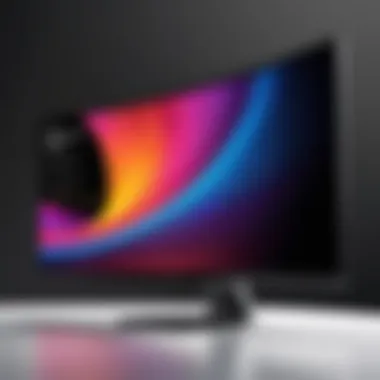
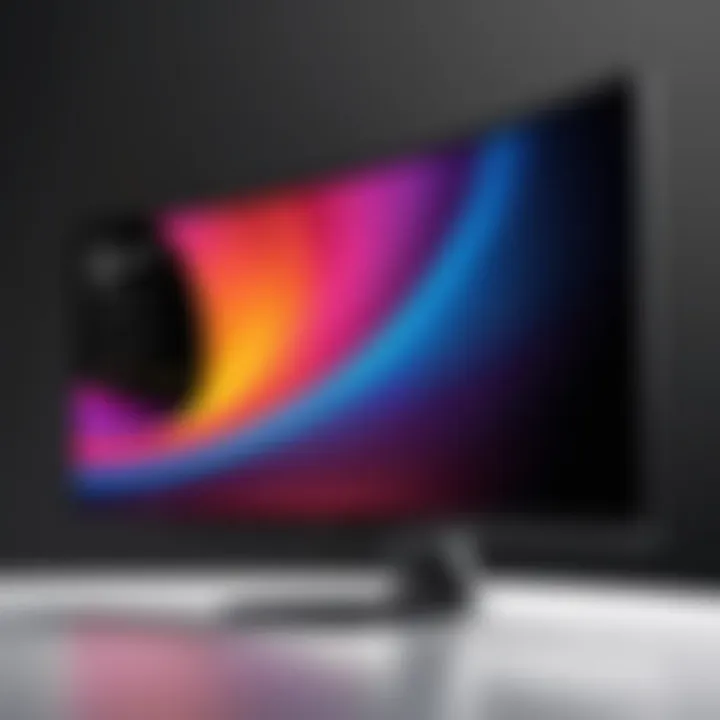
Another important aspect is the reduced glare and reflections that often accompany flat screens. Curved designs can minimize disruptions caused by ambient lighting, ensuring that everyone can focus on the material being shared. This is crucial when sharing complex data or visuals, as clarity in communication can lead to more productive discussions.
Moreover, these monitors often come with features that support multi-display setups. Users can seamlessly integrate multiple screens, enhancing collaborative workflows even further. Teams can work together on projects with increased visibility, fostering a sense of unity and collaborative spirit.
Versatility in Various Applications
Curved monitors demonstrate versatility across different applications. They are not only suited for gaming or graphic design but also for general office work and professional presentations. In a typical office setting, these monitors can adapt to various tasks such as data analysis, video conferencing, and content creation.
In terms of design work, the curvature of the monitor provides a more immersive experience, allowing designers to dive deeper into their projects without the constraints of flat edges. The enhanced color accuracy and better contrast also ensure that the details remain sharp and vibrant, crucial for precise work.
For professionals in finance or data-heavy industries, the ability to view large datasets simultaneously is a major advantage. With a larger workspace afforded by the curvature, users can open multiple windows side by side, making multitasking simpler and more efficient. This makes it easier to glean insights from data without constant switching between tabs.
Considerations Before Purchase
When considering a curved computer monitor, take's important to reflect on how it fits into your work or gaming environment. This decision may affect both performance and user satisfaction. The benefits of a curved monitor are many, but understanding the specific considerations before making a purchase can ensure that you gain the most from your investment.
Desk Space and Setup
Assessing the available desk space is crucial before acquiring a curved monitor. These monitors can take up more room than traditional flat screens due to their design and curvature. You need to evaluate your workspace to ensure there is enough surface area to accommodate the monitor's dimensions. The depth and height should align with your sitting position to maintain ergonomic comfort.
Consider the monitor's stand; some models have bulky bases. Alternatives such as wall mounts or adjustable arms can provide flexibility in limited spaces. Make sure to have appropriate cabling and power sources ready, as a curved monitor might require different connections than what is currently being used.
- Measure your desk: Take careful measurements of your desk to determine if the curved monitor fits well.
- Plan monitor height: Align the screen with eye level to avoid strain.
- Evaluate surrounding equipment: Ensure enough space for other devices like keyboards and speakers.
Compatibility with Existing Hardware
It’s also vital to address the compatibility issues with your current hardware. Curved monitors often require specific video outputs, such as HDMI or DisplayPort. Analyze what outputs your computer or gaming system supports. If your existing hardware lacks the right ports, you might need to invest in adaptors or a new graphics card.
Before purchasing, you should check the monitor’s specifications. Ensure that it can effectively work with your computer's resolution and refresh rates. Some advanced curved monitors provide features like higher refresh rates and adaptive sync technologies which may not function well with older systems.
- Check connection types: Ensure your graphics card supports necessary connections.
- Examine resolution compatibility: Ensure your device can output the resolution the monitor requires.
- Identify any upgrade needs: Determine whether your current hardware meets the performance needs of a new monitor.
Curved monitors are designed to enhance the user experience, yet failing to consider desk setup and compatibility can lead to inefficient use.
These considerations can make the difference between a satisfactory purchase and frustration. It’s recommended to plan ahead and ensure a smooth integration of a curved monitor into your digital workspace.
Future of Curved Monitors
The future of curved monitors is of great significance in the current technological landscape. As more users seek enhanced visual experiences, manufacturers are investing in innovations that elevate curved display performance. The evolution of this product category is set to redefine how we interact with screens, affecting both productivity and leisure. Acknowledging the future of curved monitors helps consumers make informed choices that align with their needs.
Advancements in Technology
Technological advancements are pivotal to the progression of curved monitors. Several innovations are expected to shape the future of these displays:
- Higher Resolutions: With 8K and beyond becoming a reality, curved monitors will likely embrace these higher resolutions, offering sharper and more vibrant images.
- Flexible Displays: The potential for flexible OLED technology could allow for screens that adapt to various use cases, providing immersive experiences from different angles.
- Enhanced Refresh Rates: Fast-paced gaming and video are becoming more demanding. Future monitors may incorporate higher refresh rates to ensure smoother visuals, critical for competitive gaming.
These advancements not only improve the visual experience but also cater to various user preferences, whether in gaming, multimedia consumption, or professional environments.
Industry Trends
Observing industry trends is crucial to understanding the direction of curved monitors. Key trends to note:
- Sustainability Initiatives: Manufacturers are shifting toward eco-friendly practices. This includes using sustainable materials and energy-efficient production processes.
- Game-Centric Designs: There is an increasing focus on designing monitors that enhance the gaming experience. Features like customizable RGB lighting and specialized gaming modes are becoming common.
- Hybrid Work Solutions: With remote work being more prevalent, monitors that support multitasking and collaboration tools are in demand. Curved monitors can provide ample screen real estate, which is beneficial for productivity.
"The future of curved monitors is not just about visual technology but also about how these devices adapt to changing user behaviors and environments."
As the market continues to adapt to consumer needs and technological innovation, curved monitors are poised to become a mainstream choice for many users. Their potential to enhance both performance and comfort makes them a compelling option to consider moving forward.





